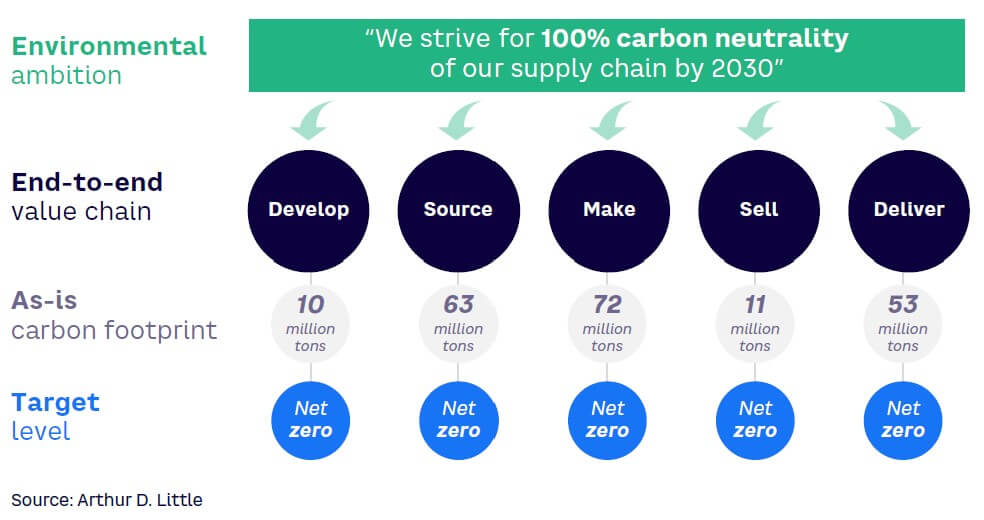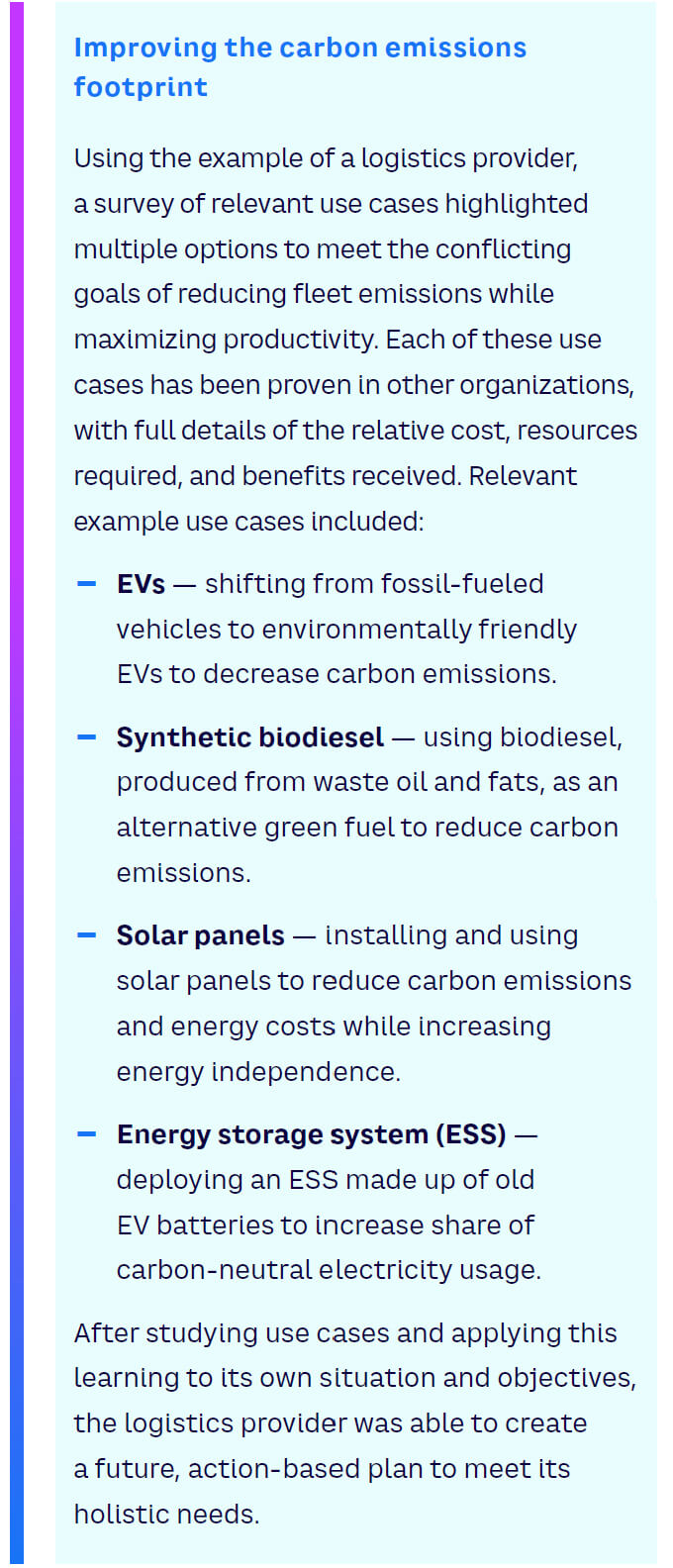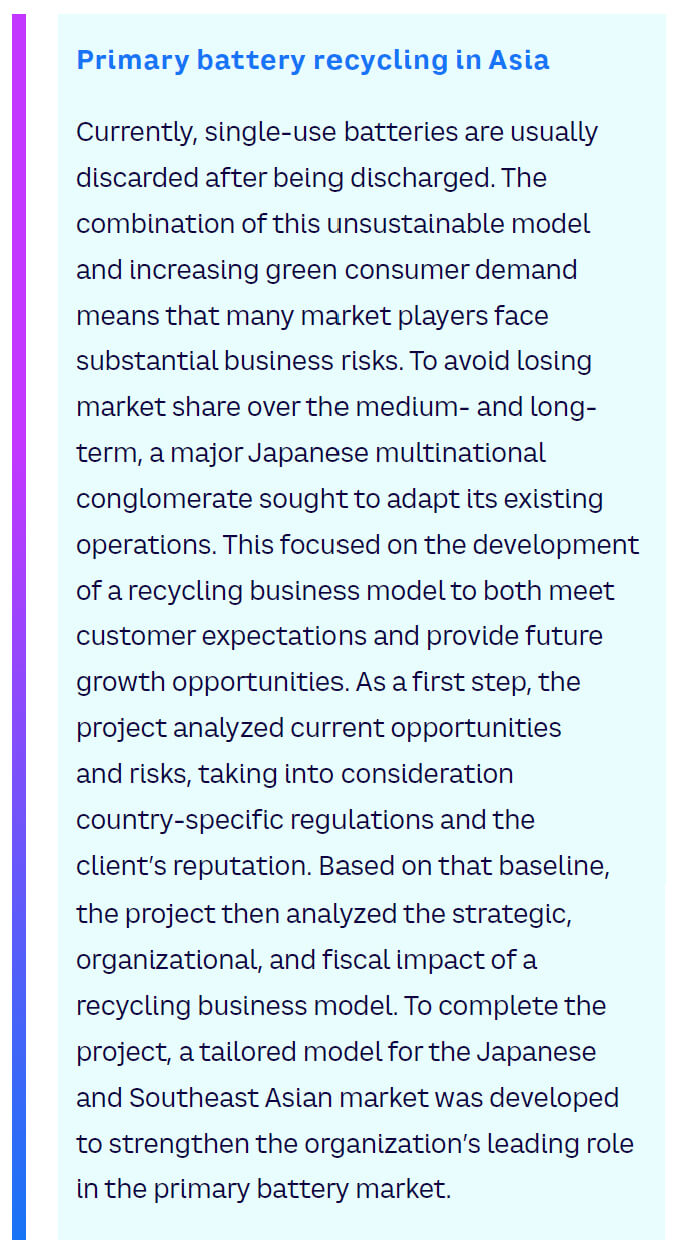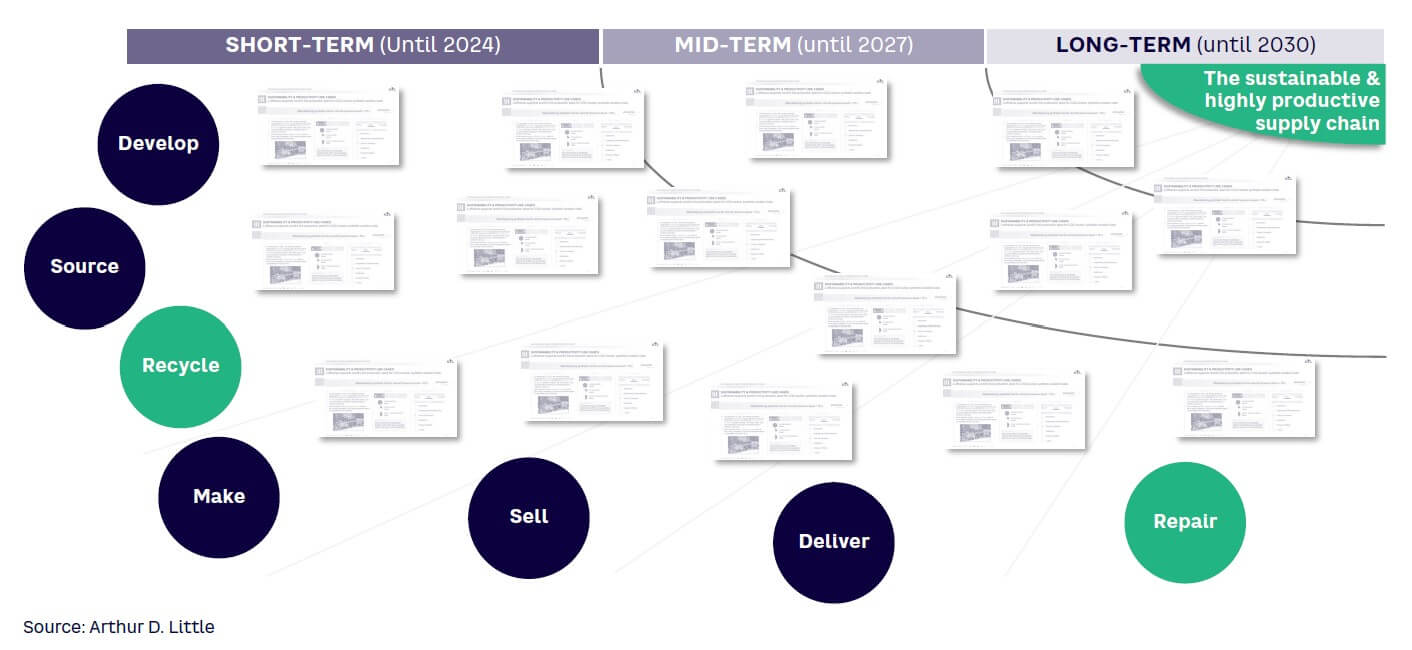
Supply chains are under unprecedented strain, impacting productivity and leading to shortages for consumers and manufacturers alike. At the same time, companies face growing pressure from society and regulators to become more sustainable, which opens up new opportunities with customers increasingly willing to pay a premium for more sustainable products. Meeting these conflicting objectives requires a comprehensive approach that future-proofs supply chains by delivering both greater sustainability and higher productivity.
BUSINESS DRIVERS FOR SUSTAINABLE, PRODUCTIVE SUPPLY CHAIN
Since the onset of the Industrial Age, companies have invested heavily in building ever more complex, global supply chains. These optimize operations and maximize productivity by delivering raw materials, subcomponents, and finished goods seamlessly to the right place at the right time. However, these models are increasingly under threat, with supply chains becoming more volatile due to factors such as:
-
Rising costs. According to the World Bank, 2023 energy prices are expected to be 75% above their average over the past five years. Commodity prices remain high compared to historic levels.
-
Resource scarcity. This can either be permanent (e.g., shortages of materials required for electric vehicle [EV] batteries) or temporary (e.g., supply chain disruption caused by COVID-19 or the shutting of the Suez Canal).
-
Geopolitics. This includes sanctions (e.g., on Russia) and growing economic protectionism by many countries.
-
Greater requirements around sustainability, driven by consumers and investors. Recent studies reveal that a growing proportion of consumers are willing to pay a premium for more sustainable products.
-
Growing international regulatory obligations. This encompasses increasing legislation in areas as diverse as emissions reduction and working conditions.
-
War for talent. This requires companies to attract and retain the best employees if they are to outperform rivals.
-
Greater competition. Digitization is opening all markets, lowering the barriers to entry for a wider range of nontraditional players.
-
Transportation capacity and prices. Global ports are filled with containers, while shipping prices are at an all-time high. Air cargo costs have also increased dramatically.
None of these trends is likely to end soon, and the impact of many will only deepen over time. This requires new thinking around planning and managing supply chains, which must become more resilient and future-proof, balancing the demands of productivity and sustainability.
To succeed, organizations need to ask (and answer) these questions:
-
What does “sustainability” mean for us?
-
How can we make our supply chain both sustainable and productive, and how can we achieve a successful balance?
-
What should be covered by holistic sustainability management?
-
How does sustainability influence our organization in general — and our supply chain in particular?
-
What should transformation toward a sustainable and highly productive supply chain look like for our business?
-
How can we create tangible impact and value to increase sustainability and productivity?
5 steps to creating value from supply chain sustainability & productivity
Addressing these drivers means supply chain leaders need to oversee a transformation that covers both:
-
Productivity — optimizing supply chain efficiency, profitability, and resilience using technology and human skills.
-
Sustainability — making supply chains greener and more sustainable across all environmental, social, and governance (ESG) factors.
This holistic transformation is best achieved through a combination of careful strategic planning and focused tactical action via a use case–based approach. Changes are then based on proven, relevant actions, enabling organizations to meet potentially conflicting demands. We recommend companies take these five steps to successfully transform their supply chains (see Figure 1):
-
Supply chain baseline analysis
-
Supply chain ambition development
-
Use case definition and prioritization
-
Supply chain target picture development
-
Supply chain roadmap definition

SUPPLY CHAIN BASELINE ANALYSIS: WHAT IS OUR STARTING POINT?
Begin by evaluating where you are now. What are your current challenges from both a productivity and ESG point of view?
Analyzing productivity challenges
Productivity challenges include:
-
Insufficient resources (from ideas for change to relevant competencies and skills).
-
Cultural/organizational factors and silos that mean local teams and stakeholders do not buy into or act on overall strategy.
Such challenges make it difficult to improve performance rapidly enough to drive transformational change.
Analyzing ESG challenges
From a sustainability standpoint, it is vital to know your current position to develop a goal-oriented supply chain ambition. This requires a 360-degree/holistic assessment that covers all areas of ESG:
-
Environmental — reducing the supply chain carbon footprint.
-
Social — areas such as health and safety/social responsibility.
-
Governance — including business ethics and compliance.
A key challenge for many organizations is accurately measuring their carbon footprint. Technology can bridge this gap. Artificial intelligence (AI)-driven solutions help companies measure, simulate, and track their carbon footprint across all aspects of their supply chains. These state-of-the-art CO2 footprint analysis solutions not only measure emissions directly produced by the company’s activities (Scope 1 and 2) but also measure the more complex indirect emissions (Scope 3) produced along the company’s entire value chain.
SUPPLY CHAIN AMBITION DEVELOPMENT: WHAT IS OUR AIM?
Once you understand the supply chain picture from a productivity and sustainability perspective, you can use it to develop your long-term ambition. This should act as your North Star. It will provide strategic guidance and define your sustainability and productivity ambitions. These could include targets such as:
-
Environmental — 100% carbon-neutral supply chain by 2030.
-
Social — responsible sourcing for the business and across the supply chain by 2028.
-
Governance — become the industry leader for diversity and inclusion by 2025.
-
Productivity — 10% return on capital employed; US $1 million in revenue generated per employee; 10% total shareholder returns by 2030.
After setting these long-term objectives, you can then derive a target picture for each part of the supply chain in a holistic context. The next step is to analyze the gap between the current situation and your overall ambitions and use this insight to prioritize areas for action across the value chain. Figure 2 shows an organization’s present status compared to the ambition of achieving 100% carbon neutrality, broken down across the supply chain to provide measurable targets.

USE CASE DEFINITION & PRIORITIZATION: WHAT ARE BEST PRACTICES?
Organizations across industries are facing the same challenges. Some are more advanced, which can represent invaluable learning opportunities for those that follow. Rather than reinvent the wheel, companies should collect, understand, and implement best practice through quantified use cases. These can inspire your own use cases, adapted to your needs. They provide a concrete path to action, as the example in the sidebar, “Improving the carbon emissions footprint,” illustrates.
It is critical to analyze the widest range of use cases across different sectors before choosing which to deploy. Use cases should span multiple industries, quantifying their impacts on sustainability and productivity as well as the relationship between cost and implementation. They should aim to stimulate change, providing concrete external examples to help deliver the sustainability and productivity ambitions of all organizations.
After identifying relevant use cases, companies should prioritize actions according to their sustainability and productivity potential. Then, act fast to pilot those with the highest potential, learn from the process, and then scale depending on the results.

SUPPLY CHAIN TARGET PICTURE: WHAT IS OUR TARGET PICTURE?
After defining their long-term supply chain ambition and prioritizing relevant use cases, companies should then build an integrated target picture for each part of the supply chain. This provides clear guidance on building the future supply chain, integrating use cases to achieve long-term ambitions. It also opens up thinking to new concepts, such as embracing circular supply chains and adopting concepts such as recycling, reuse, and refurbishment of products and materials.
Three key principles should underpin transformation of the supply chain target picture into practice:
-
Commitment from senior management, embedded in their agenda.
-
Accountability throughout the organization, making targets an integral part of all operations.
-
Integration of transformation program structures into the overall organizational structure to ensure that alignment.
When it comes to the supply chain target picture, there is no single solution. Companies must tailor their approach with regard to structures, governance, resources, and business model. For example, Unilever has established sustainability governance structures and clear lines of accountability on both a strategic and operational level. It has embedded its commitment to sustainability in its business agenda through its purpose, vision, and business model. It is also open to outside influences, looking for external advice from a variety of sources, including an Advisory Council made up of nongovernmental organizations (NGOs) and academics.

SUPPLY CHAIN ROADMAP DEFINITION: HOW CAN WE ACHIEVE OUR GOALS?
Optimizing the supply chain requires a clear, implementation-ready roadmap with specific actions. Prioritize actions to break this roadmap into a short-, medium-, and long-term implementation plan (see the example in Figure 3, where actions are organized by time horizon and value chain focus). Put in place a program organization to ensure goal-oriented, coordinated design and action implementation based on clear, predefined responsibilities, timelines, and resources.

Conclusion
TAKING A HOLISTIC SUPPLY CHAIN APPROACH
Supply chain pressures are overpowering existing structures, impacting productivity and sustainability. To overcome these challenges, companies must take a holistic, transformational, and use case–driven approach to:
-
Understand your current position.
-
Set long-term ambitions.
-
Understand use case options and relate them to your business.
-
Build a medium-term supply chain target picture.
-
Translate into short-term concrete roadmaps.
-
Pilot rapidly, learn, iterate, and deploy.
This transformation will help an organization define and implement a clear supply chain target picture to achieve tangible results in a structured way. Now is the time to start the journey and build a sustainable and highly productive supply chain — both for the good of the business and for greater society.



